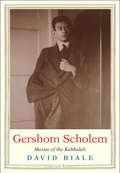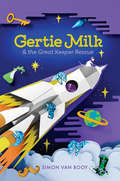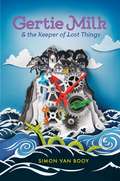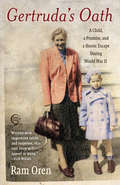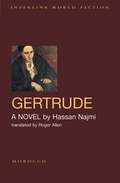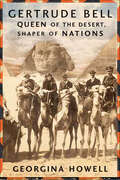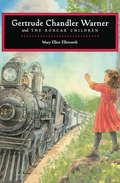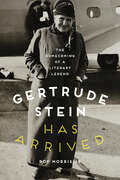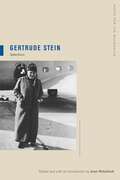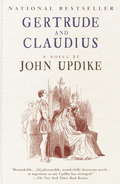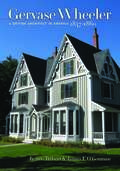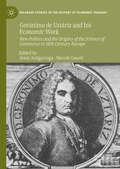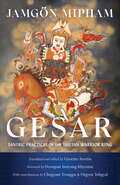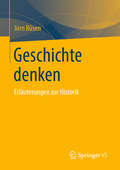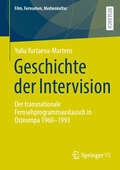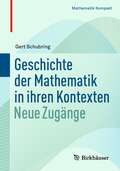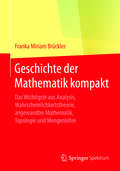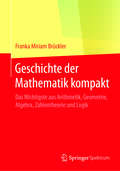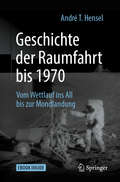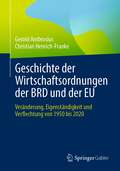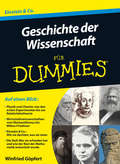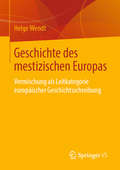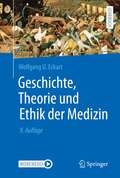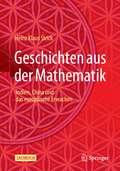- Table View
- List View
Gershom Scholem: Master of the Kabbalah (Jewish Lives)
by David BialeA new biography of the seminal twentieth-century historian and thinker who pioneered the study of Jewish mysticism and profoundly influenced the Zionist movement Gershom Scholem (1897–1982) was perhaps the foremost Jewish intellectual of the twentieth century. Pioneering the study of Jewish mysticism as a legitimate academic discipline, he overturned the rationalist bias of his predecessors and revealed an extraordinary world of myth and messianism. In his youth, he rebelled against the assimilationist culture of his parents and embraced Zionism as the vehicle for the renewal of Judaism in a secular age. He moved to Palestine in 1923 and participated in the creation of the Hebrew University, where he was a towering figure for nearly seventy years. David Biale traces Scholem’s tumultuous life of political activism and cultural criticism, including his falling-out with Hannah Arendt over the Eichmann trial. Mining a rich trove of diaries, letters, and other writings, Biale shows that his subject’s inner life illuminates his most important writings. Scholem emerges as a passionately engaged man of his times—a period that encompassed two world wars, the rise of Nazism, and the Holocaust.
Gertie Milk and the Great Keeper Rescue (Gertie Milk #2)
by Simon Van BooyIn award-winning author Simon Van Booy's fantastical sequel to Gertie Milk and the Keeper of Lost Things, Gertie, Kolt, and Robot Rabbit Boy continue their adventures returning missing objects throughout history while trying to find out what happened to the imprisoned Keepers of Lost Things.Ever since Gertie Milk arrived on Skuldark, the mysterious island home of all lost objects, she's felt like something was missing. According to Kolt, her mentor and fellow Keeper of Lost Things, the island used to be filled with Keepers tasked with returning missing items throughout history. But now the only three left are Gertie, Kolt, and, Robot Rabbit Boy--a bumbling but lovable Series 7 Artificial Intelligence Forever Friend. So when Gertie learns that the missing Keepers have been imprisoned by the Losers, their unsavory adversaries, she decides to make it her mission to rescue the kidnapped Keepers and return them to Skuldark.But that proves more difficult than she'd imagined since her missions to return lost items don't seem to be taking them anywhere near the missing Keepers. Plus, it doesn't help that the Losers have an evil master plan much worse than their last one. This time, the entire future of the universe is at stake. Fueled by delicious cakes, jars of lemon curd, and plenty of Skuldarkian seawater, Gertie, Kolt, and Robot Rabbit Boy must travel through time (and outer space) to save their island home and rescue the Keepers--before the Losers manage to capture them all.
Gertie Milk and the Keeper of Lost Things (Gertie Milk #1)
by Simon Van BooyAward-winning author Simon Van Booy introduces readers to a magical, whimsical world, perfect for fans of Circus Mirandus and Serafina and the Black Cloak.When twelve-year-old Gertie Milk washes up on the island of Skuldark, she finds that all of her memories are gone. Home to helpful Slug Lamps, delicious moonberries, and a ferocious Guard Worm, the island is full of oddities, including a cozy cottage containing artifacts from every corner of history. It is there that Gertie discovers she has been chosen as the next Keeper of Lost Things, tasked with the mission of returning objects to history’s most important figures right when they need them most. With the help of a time machine disguised as a vintage sports car and the guidance of her fellow Keeper, Kolt, Gertie dodges an elephant army in ancient Alexandria, crashes a 1920s flapper party, and battles a ruthless Zhou Dynasty king. But soon, Gertie encounters an enemy that threatens everything the Keepers stand for: The Losers, villains who don't want to keep order but destroy it. Now, Gertie must uncover the truth of her own past if she wants to stop the Losers and set history back in place.
Gertruda's Oath: A Child, a Promise, and a Heroic Escape During World War II
by Ram OrenTrapped in the horrors of World War II, a woman and a child embark on a journey of survival in this page-turning true story that recalls the power and the poignancy ofSchindler’s List. Michael Stolowitzky, the only son of a wealthy Jewish family in Poland, was just three years old when war broke out and the family lost everything. His father, desperate to settle his business affairs, travels to France, leaving Michael in the care of his mother and Gertruda Bablinska, a Catholic nanny devoted to the family. When Michael's mother has a stroke, Gertruda promises the dying woman that she will make her way to Palestine and raise him as her own son. Written with the invaluable assistance of Michael, now seventy-two and living in New York City, GERTRUDA’S OATH re-creates Michael and Gertruda’s amazing journey. Gripping vignettes bring to life the people who helped ensure their survival, including SS officer Karl Rink, who made it his mission to save Jews after his own Jewish wife was murdered; Rink’s daughter, Helga, who escaped to a kibbutz, where she lived until her recent death; and the Jewish physician Dr. Berman, who aided Michael and Gertruda through the worst of times. GERTRUDA’S OATH is a story of extraordinary courage and moral strength in the face of horrific events. LikeSchindler’s List, it transcends history and religion to reveal the compassion and hope that miraculously thrives in a world immersed in war without end.
Gertrude
by Roger Allen Hassan NajmiAs Hassan Najmi's acclaimed novel begins, our unnamed narrator befriends an elderly man, Muhammad, who, as a young man, worked as a tour guide in the city of Tangier. Muhammad tells the narrator about his most famous clients, the renowned Gertrude Stein and her companion Alice Toklas, who-on the recommendation of Henri Matisse-hired Muhammad as their guide when they visited Morocco. Now close to death, Muhammad begs the narrator to take his papers and write his life story.Soon we learn that Muhammad once accepted Stein's invitation to visit her in Paris, and even lived for a time in a roof-top room in her apartment. There he participated in Stein's famous salon, meeting Picasso, Appollinaire, Hemingway, Anais Nin, and the many other luminaries in Stein's circle. As the narrator is drawn further into Muhammad's story, he finds himself also drawn into a relationship with the cultural attaché at the American Embassy in Rabat, a beautiful African-American woman who becomes as interested in the story of Stein's visit to Morocco as she obviously is in the young Moroccan who is researching it. Together they continue their quest into the past to rediscover Stein, a quest that will take them in unexpected new directions, in a novel that bursts with different varieties of passion at the hands of a master storyteller and poet.
Gertrude Bell: Queen of the Desert, Shaper of Nations
by Georgina HowellA marvelous tale of an adventurous life of great historical importShe has been called the female Lawrence of Arabia, which, while not inaccurate, fails to give Gertrude Bell her due. She was at one time the most powerful woman in the British Empire: a nation builder, the driving force behind the creation of modern-day Iraq. Born in 1868 into a world of privilege, Bell turned her back on Victorian society, choosing to read history at Oxford and going on to become an archaeologist, spy, Arabist, linguist, author (of Persian Pictures, The Desert and the Sown, and many other collections), poet, photographer, and legendary mountaineer (she took off her skirt and climbed the Alps in her underclothes).She traveled the globe several times, but her passion was the desert, where she traveled with only her guns and her servants. Her vast knowledge of the region made her indispensable to the Cairo Intelligence Office of the British government during World War I. She advised the Viceroy of India; then, as an army major, she traveled to the front lines in Mesopotamia. There, she supported the creation of an autonomous Arab nation for Iraq, promoting and manipulating the election of King Faisal to the throne and helping to draw the borders of the fledgling state. Gertrude Bell, vividly told and impeccably researched by Georgina Howell, is a richly compelling portrait of a woman who transcended the restrictions of her class and times, and in so doing, created a remarkable and enduring legacy." … there’s never a dull moment in the peerless life of this trailblazing character." - Kirkus Reviews
Gertrude Chandler Warner and the Boxcar Children
by Mary Ellen EllsworthIn this biography, readers will learn about Gertrude Chandler Warner's childhood living across the street from the railroad tracks, her bouts with poor health, and her rewarding teaching career. Most importantly, they will learn about her earliest attempts at writing and her inspiration for The Boxcar Children.
Gertrude Stein Has Arrived: The Homecoming of a Literary Legend
by Roy Morris Jr.The American book tour that catapulted Gertrude Stein from quirky artist to a household name.In 1933, experimental writer and longtime expatriate Gertrude Stein skyrocketed to overnight fame with the publication of an unlikely best seller, The Autobiography of Alice B. Toklas. Pantomiming the voice of her partner Alice, The Autobiography was actually Gertrude's work. But whoever the real author was, the uncharacteristically lucid and readable book won over the hearts of thousands of Americans, whose clamor to meet Gertrude and Alice in person convinced them to return to America for the first time in thirty years from their self-imposed exile in France. For more than six months, Gertrude and Alice crisscrossed America, from New England to California, from Minnesota to Texas, stopping at thirty-seven different cities along the way. They had tea with First Lady Eleanor Roosevelt, attended a star-studded dinner party at Charlie Chaplin's home in Beverly Hills, enjoyed fifty-yard-line seats at the annual Yale-Dartmouth football game, and rode along with a homicide detective through the streets of Chicago. They met with the Raven Society in Edgar Allan Poe's old room at the University of Virginia, toured notable Civil War battlefields, and ate Oysters Rockefeller for the first time at Antoine's Restaurant in New Orleans. Everywhere they went, they were treated like everyone's favorite maiden aunts—colorful, eccentric, and eminently quotable.In Gertrude Stein Has Arrived, noted literary biographer Roy Morris Jr. recounts with characteristic energy and wit the couple's rollicking tour, revealing how—much to their surprise—they rediscovered their American roots after three decades of living abroad. Entertaining and sympathetic, this clear-eyed account captures Gertrude Stein for the larger-than-life legend she was and shows the unique relationship she had with her indefatigable companion, Alice B. Toklas—the true power behind the throne.
Gertrude Stein: Selections (Poets for the Millennium #Volume 6)
by Joan RetallackThis selection of Gertrude Stein's work is taken from the period between 1905 and 1936, when the iconic modernist poet was engaged in an astounding number of still-surprising literary experiments, whose innovations continue to influence all the arts. Editor Joan Retallack has chosen complete texts or selections that lend themselves to a clarified vision of Stein's oeuvre. In her brilliant introduction, Retallack provides the historical and biographical context for Stein's lifelong project of composing a 'continuous present,' an effort which parallels many of the most important technological and scientific developments of her era - from moving pictures to Einstein's revision of our understanding of space and time. Retallack also addresses persistent questions about Stein's work and the best way to read it in our contemporary moment. In suggesting a performative 'reading poesis' for these works, Retallack follows Stein's dictum by arguing that to actively experience the work is to enjoy it, and to enjoy it is to understand it.
Gertrude and Claudius
by John UpdikeGertrude and Claudius are the "villains" of Hamlet: he the killer of Hamlet's father and usurper of the Danish throne, she his lusty consort, who marries Claudius before her late husband's body is cold. But in this imaginative "prequel" to the play, John Updike makes a case for the royal couple that Shakespeare only hinted at. Gertrude and Claudius are seen afresh against a background of fond intentions and family dysfunction, on a stage darkened by the ominous shadow of a sullen, erratic, disaffected prince. "I hoped to keep the texture light," Updike said of this novel, "to move from the mists of Scandinavian legend into the daylight atmosphere of the Globe. I sought to narrate the romance that preceded the tragedy."
Gervase Wheeler: A British Architect in America, 1847–1860 (The Driftless Connecticut Series)
by James F. O'Gorman Renee TribertGervase Wheeler was an English-born architect who designed such important American works as the Henry Boody House in Brunswick, Maine; the Patrick Barry House in Rochester, New York; and the chapels at Bowdoin and Williams colleges. But he was perhaps best known as the author of two influential architecture books, Rural Homes (1851) and Homes for the People (1855). Yet Wheeler has remained a little known, enigmatic figure. Renee Tribert and James F. O'Gorman's study sheds new light on the course of Wheeler's career in the states, and brings crucial issues to the fore--the international movement of ideas, the development of the American architectural profession, the influence of architectural publications on popular taste, and social history as expressed in the changing nature of the American house. Wheeler's career is traced chronologically and geographically and the book is lavishly illustrated with over fifty images, including building plans and historical photographs.
Gerónimo de Uztáriz and his Economic Work: New Politics and the Origins of the Science of Commerce in 18th Century Europe (Palgrave Studies in the History of Economic Thought)
by Jesús Astigarraga Niccolò GuastiThis book provides a detailed and compelling guide to the life and economic work of Gerónimo de Uztáriz. It contextualises his work within the economic and political trends of the time, including the Enlightenment, Spanish liberalism, and colonial empires. Particular attention is given to de Uztáriz’s seminal work Theórica y Práctica de comercio y de marina and how it achieved international circulation and recognition. Its influence on 18th century Spain is examined, alongside a detailed analysis of the trade systems of the day. The translation and reception of Theórica in France, Great Britain, Italy, Ireland, and Germany is also discussed. This book aims to shed new light upon the economic work of Gerónimo de Uztáriz and highlights why his ideas remain relevant and important. It will be of interest to students and researchers working within modern history and the history of economic thought.
Gesar: Tantric Practices of the Tibetan Warrior King
by Jamgon MiphamGesar of Ling is well known in Tibetan history, literature, and folklore. But, for Buddhist practitioners, he is an enlightened tantric protector and deity—an emanation of Padmasambhava. Engaging in Gesar practice is meant to generate positive circumstances and increase one&’s experiences and realization in Buddhist practice.Gesar of Ling is widely known as the hero of Tibet&’s national oral epic, considered the longest epic in the world. But he is also the focus of Buddhist practices in which his enlightened form, known as King Gesar the Jewel, becomes one of the numerous spiritual methods offered by Tibetan Vajrayana Buddhism to progress toward buddhahood. This work contains the complete selection of practice texts compiled by the early modern Tibetan polymath Jamgon Mipham and included in his Collected Works. Gesar personifies the ideal of the spiritual warrior, who tames negative forces which obstruct the Buddhist path. The practices presented here detail poetic imagery of offerings and their recipients, including Gesar, his court, and the spirits who dwell in his personal belongings. Vajrayana practices such as these are considered mind treasures, meaning rather than being composed, they appeared fully formed as a transmission with the mind of a Vajrayana master.The practices in this book are meant to be done only by those who have received Gesar Dorje Tsegyal empowerment or &“entrustment with his life force,&” the reading transmission of the practice, and the associated instructions from a qualified master.
Geschichte denken: Erläuterungen zur Historik
by Jörn RüsenDieser Band bietet einen vielgestaltigen Überblick zu den Grundfragen der Historik und des historischen Denkens. Prof. Dr. Dr. h.c. mult. Jörn Rüsen ist Historiker und Kulturwissenschaftler.
Geschichte der Intervision: Der transnationale Fernsehprogrammaustausch in Osteuropa 1960–1993 (Film, Fernsehen, Medienkultur)
by Yulia Yurtaeva-MartensDie Immanenz des internationalen Programmaustausches im Medium Fernsehen aufzuzeigen, ist das zentrale Anliegen dieses Bandes. Die Studie legt eine systematische Analyse der Entstehung, Entwicklung und Tätigkeit der Intervision vor, einer osteuropäischen – und aus heutiger Sicht transnationalen – Organisation, die 1960 zur Koordinierung des Fernsehprogrammaustausches ins Leben gerufen wurde. Den Schwerpunkt der Arbeit bildet die qualitative und quantitative Auswertung des Programmaustausches innerhalb der Intervision sowie deren Zusammenarbeit mit der westeuropäischen Eurovision unter Berücksichtigung der damaligen politischen und technologischen Rahmenbedingungen und Implikationen. Die analytische Betrachtung erstreckt sich dabei auf den gesamten Zeitraum des Bestehens der Intervision von 1960 bis 1993. Mit dieser umfassenden Untersuchung liefert der Band wertvolle Einblicke in die Mechanismen und Dynamiken des europäischen Fernsehprogrammaustausches in den Zeiten des Kalten Krieges und schließt an die gegenwärtige Forschung zum sozialistischen Fernsehen aus transnationaler Perspektive an.
Geschichte der Mathematik in ihren Kontexten: Neue Zugänge (Mathematik Kompakt)
by Gert SchubringDieses Buch ist konzipiert für angehende und praktizierende Mathematiklehrer; es richtet sich aber auch generell an Studierende der Mathematik. Ebenso wird es einem an Mathematik interessierten Leser neue Zugänge zur Mathematik eröffnen.Kenntnisse in Geschichte der Mathematik werden stets wichtiger als Bestandteil der Mathematiklehrer-Ausbildung: zur Vertiefung des Begriffs-Verständnisses und aufgrund der in der Mathematik-Didaktik international stets stärker empfohlenen Einbeziehung der Mathematik-Geschichte in den Mathematikunterricht – um durch die Vorzüge einer „genetischen“ Methodik die Begriffsentwicklung bei den Schülern effektiver gestalten zu können. Das Buch will zur Ausbildung von „Metawissen“ beitragen – von Wissen über das Fachwissen. Anstatt der häufigen Reduktion der Mathematik-Geschichte in Lehrbüchern auf anekdotische Informationen oder der Beschränkung auf wenige, als ‚große‘ präsentierte Mathematiker und auf ideengeschichtliche Entwicklungen eröffnet das Buch, auf dem aktuellen Stand der historischen Forschung, neue Zugänge zum Verständnis der Begriffs-Entwicklungen durch deren Darstellung in ihren kulturellen und sozialen Kontexten. Zudem leitet das Buch dazu an, traditionelle historische Berichte aufgrund neuerer Methodologien kritisch zu hinterfragen.Den meisten Kapiteln sind Aufgaben hinzugefügt, teils zur Vertiefung der Themen des Kapitels, teils als Anregung zur eigenen Praxis, um sie etwa selbst im Unterricht einzusetzen.
Geschichte der Mathematik kompakt: Das Wichtigste aus Analysis, Wahrscheinlichkeitstheorie, angewandter Mathematik, Topologie und Mengenlehre
by Franka Miriam BrücklerDieses Buch gibt einen kompakten Überblick über die historische Entwicklung und Ideengeschichte derjenigen mathematischen Gebiete, die sich erst in der Neuzeit zu eigenständigen Teildisziplinen entwickelt haben: Analysis, Wahrscheinlichkeitstheorie, angewandte Mathematik, Topologie und Mengenlehre. Die Darstellung verzichtet auf Vollständigkeit und konzentriert sich stattdessen ganz bewusst auf wesentliche oder besonders interessante Aspekte: Einzelne Persönlichkeiten und Ideen werden exemplarisch herausgegriffen und detaillierter dargestellt als andere – es entsteht jedoch insgesamt ein stimmiges, ausgewogenes und dennoch übersichtliches Gesamtbild. Dabei wird insbesondere begreifbar, dass die historische Entwicklung der Mathematik von zahlreichen Einflüssen angetrieben wurde, dass zahlreiche theoretische Resultate aus ganz praktischen Gründen gefunden wurden (und umgekehrt), und dass es zu den wenigsten mathematischen Problemen nur einen (richtigen) Lösungsweg gibt. Auch Querverbindungen zwischen den verschiedenen Disziplinen werden deutlich. Das Buch wendet sich an all jene, die eine übersichtliche, kurze Darstellung der zentralen Momente in der Geschichte der Mathematik suchen – vor allem Professoren, (zukünftige) Lehrer und Studierende.
Geschichte der Mathematik kompakt: Das Wichtigste aus Arithmetik, Geometrie, Algebra, Zahlentheorie und Logik
by Franka Miriam BrücklerDieses Buch gibt einen kompakten Überblick über die historische Entwicklung und Ideengeschichte derjenigen mathematischen Disziplinen, die sich schon bis zur Renaissancezeit weitgehend eigenständig entwickelt haben: Arithmetik, Geometrie, Algebra, Zahlentheorie und mathematische Logik. Die Darstellung verzichtet auf Vollständigkeit und konzentriert sich stattdessen ganz bewusst auf wesentliche oder besonders interessante Aspekte: Einzelne Persönlichkeiten und Ideen exemplarisch herausgegriffen und detaillierter dargestellt als andere – es entsteht jedoch insgesamt ein stimmiges, ausgewogenes und dennoch übersichtliches Gesamtbild. Dabei wird insbesondere begreifbar, dass die historische Entwicklung der Mathematik von zahlreichen Einflüssen angetrieben wurde, dass zahlreiche theoretische Resultate aus ganz praktischen Gründen gefunden wurden (und umgekehrt), und dass es zu den wenigsten mathematischen Problemen nur einen (richtigen) Lösungsweg gibt. Auch Querverbindungen zwischen den verschiedenen Disziplinen werden deutlich. Das Buch wendet sich an all jene, die eine übersichtliche, kurze Darstellung der zentralen Momente in der Geschichte der Mathematik suchen – vor allem Professoren, (zukünftige) Lehrer und Studierende.
Geschichte der Raumfahrt bis 1970: Vom Wettlauf ins All bis zur Mondlandung
by André T. HenselIn diesem Buch finden Sie eine informative Darstellung der Entwicklung der Raumfahrt bis zum Beginn der 70er Jahre. Nach einem Einblick in die Anfänge der Raketenentwicklung beleuchtet dieses Werk, in welchem technischen, aber vor allem auch weltpolitischen Umfeld sich der Wettlauf ins All nach dem Zweiten Weltkrieg vollzogen hat. Es verdeutlicht, wie dieser Race to Space zwischen den Supermächten USA und Sowjetunion einerseits den Weltraum zum größten Kriegsschauplatz des Kalten Krieges gemacht hat, andererseits aber auch die Eroberung des Orbits mit unbemannten Satelliten und später die bemannte Raumfahrt vorangebracht hat. Zahlreiche Erfolge und Rekorde, aber auch dramatische Rückschläge und Katastrophen auf beiden Seiten, haben diese Zeit begleitet und gipfelten im spektakulären Ende dieses Rennens: dem ersten Spaziergang von Neil Armstrong und Buzz Aldrin auf dem Mond.Zum 50. Jahrestag der Mondlandung bietet André T. Hensel einen Blick zurück in diese spannende Pionierzeit der Raumfahrt. Sowohl Fachleute und Dozenten, aber auch raumfahrtbegeisterte Laien bekommen mit diesem Buch einen aufschlussreichen, detaillierten und kurzweilig zu lesenden Überblick über diese Epoche. Die folgenden Entwicklungen nach 1970, vom auslaufenden Apollo-Programm über die Raumstationen Mir und ISS bin hin zum Space Shuttle sowie die mögliche Zukunft der Raumfahrt werden in einem zweiten Band des Autors dargestellt.
Geschichte der Raumfahrt bis 1975: Vom Wettlauf ins All bis zur Mondlandung
by André T. HenselDieses Sachbuch bildet den 1. Band einer Trilogie zur Geschichte der Raumfahrt und befasst sich mit der Pionierzeit der Raumfahrt bis 1975. Schwerpunkte der Darstellung aus der ersten Hälfte des 20. Jahrhunderts sind die theoretische Begründung der Kosmonautik, die ersten praktischen Versuche in der Zwischenkriegszeit und das deutsche Raketenprogramm im Zweiten Weltkrieg. Im Zentrum der Darstellung zur Nachkriegszeit steht der Wettlauf ins All (Space Race) zwischen den beiden Supermächten USA und Sowjetunion.Detailliert und spannend werden die konkurrierenden Raumfahrtprogramme in Ost und West gegenübergestellt, die den Weltraum zum größten Kriegsschauplatz des Kalten Krieges werden ließen. Zunächst wird der Wettlauf um den ersten Satelliten und den ersten Menschen im All beschrieben, der anschließend seinen Höhepunkt im Wettlauf zum Mond fand. Darüber hinaus wird auch der Wettlauf um das erste Raumlabor beschrieben sowie der versöhnliche Abschluss des Space Race 1975 mit der Apollo-Sojus-Kopplung. Das letzte Kapitel befasst sich mit den Anfängen der westeuropäischen Raumfahrt bis zur Gründung der europäischen Raumfahrtagentur ESA im Jahr 1975.Die Trilogie richtet sich sowohl an Fachleute, als auch an interessierte Laien, die einen aufschlussreichen, detaillierten, tiefgründigen und spannenden Einblick in die Geschichte der Raumfahrt erhalten wollen. Die Fortsetzung bildet der 2. Band, welcher den Zeitraum von 1975 bis 2000 behandelt. Damit entwickelt sich die Trilogie zu einem neuen Standardwerk.
Geschichte der Wirtschaftsordnungen der BRD und der EU: Veränderung, Eigenständigkeit und Verflechtung von 1950 bis 2020
by Gerold Ambrosius Christian Henrich-FrankeDie Entwicklung der Wirtschaftsordnungen der BRD und EU werden in systematischer, chronologischer und vergleichender Perspektive behandelt. Dieser integrative Zugriff ermöglicht eine Darstellung der relationalen Beziehungen beider Ordnungen, d.h. ihrer Verbindungen, Verschmelzungen, aber auch separaten Entwicklungen. Dabei werden sowohl die Gesamtordnung als auch die wichtigsten Teilordnungen untersucht. Es wird dargelegt, wie die gemeinschaftliche Wirtschaftsordnung allmählich die bundesrepublikanische überformte.
Geschichte der Wissenschaft fur Dummies (Für Dummies)
by Winfried G¿pfertDas Wichtigste zur Geschichte von Natur-, Geistes- und Sozialwissenschaften − von der Antike bis heute Die Wissenschaftsgeschichte ist vielleicht der längste Krimi, der je geschrieben wurde. Winfried Göpfert stellt Ihnen vergessene Genies, bewunderte Scharlatane und ehrliche Geistes arbeiter vor, die unser heutiges Wissen geprägt haben. Er führt Sie durch die Geistesgeschichte und bringt Ihnen Begriffe wie Empirie und Objektivität näher. Auf einem Streifzug durch die Naturwissenschaften erfahren Sie, worüber sich Pasteur und Liebig, Newton und Leibniz, Bohr und Einstein stritten. Aber auch die Geistes- und Sozialwissenschaften kommen nicht zu kurz: Sie erfahren das Spannendste zur Geschichte der Geschichte, Soziologie, Ethik und der Wirtschafts wissen - schaften. Sie erfahren: • Was Primzahlen sind • Wie die Biologie die Vorstellung des Menschen von sich selbst auf den Kopf stellte • Wer Fernrohr, Mikroskop und Co. erfunden hat • Was sich vom Aderlass bis zur Herztransplantation so alles ereignete • Welche Rolle Frauen in der Wissenschaft spielten • Wer die größten Forscher der Geschichte waren und wer die größten Betrüger
Geschichte des mestizischen Europas: Vermischung als Leitkategorie europäischer Geschichtsschreibung
by Helge WendtDie Geschichtswissenschaft in Europa, so hat es den Anschein, gestaltet ihre Methodologie aus einer Abgrenzung gegenüber nicht-europäischen Tendenzen und verpasst damit die Chance, ihren eigenen Reichtum zu verdeutlichen und neue Argumente in einem globalisierten Diskursfeld einbringen zu können. Es ist an der Zeit, die europäische Geschichte als eine Vielzahl von Vermischungsprozessen zu verstehen, die durch Europas Teile und durch die globale Eingebundenheit des Kontinents seit der Antike stattgefunden haben. Und obwohl diese historische Leitkategorie verneint, verdrängt und verschwiegen wurde, sollten Historikerinnen und Historiker es wagen, genau diese Verbindungen und Vermischungen zu erforschen und neue Beispiele zu finden.
Geschichte, Theorie und Ethik der Medizin
by Wolfgang U. EckartGeschichte, Theorie und Ethik der Medizin auf dem neuesten Stand Das Lehrbuch für den Querschnittsbereich „GTE“: Es vermittelt die wesentlichen Grundlagen über Geschichte, Theorie und Ethik der Medizin spannend und anschaulich. Die verschiedenen Epochen der Medizingeschichte werden vielfältig beleuchtet und Brücken zu den aktuellen Herausforderungen in medizinischer Ethik und Theorie geschlagen. Der leicht verständliche Schreibstil vermittelt das Fach besonders lebendig und unterhaltsam. Der Inhalt - gezielte Prüfungsvorbereitung durch Zusammenfassungen und Definitionen - das kompakte und spannende Nachschlagewerk - umfangreiches Kapitel zu Ethik und Recht der Medizin auf dem aktuellen Stand- Ergänzungen zu den großen Seuchen inklusive extra Kapitel zur Corona-Pandemie Der Überblick für den Querschnittsbereich GTE: Lernen, schmökern, nachschlagen
Geschichten aus der Mathematik: Indien, China und das europäische Erwachen
by Heinz Klaus StrickUnser heutiges Bild von Mathematik ist geprägt von der Entwicklung des Fachs auf unserem europäischen Kontinent. Andere Kulturen spielten und spielen in unserem Bewusstsein kaum eine Rolle. Welchen Austausch von mathematischem Wissen gab es – schon im Altertum und seit Beginn der Neuzeit – etwa mit den Wissenschaftlern des indischen Subkontinents? Oder gar mit den chinesischen Mathematikern? Die Quellenlage ist unsicher – doch bereits im alten China wurde eine Fülle von Schreibweisen und Techniken entwickelt, die erst sehr viel später auch in Indien und in Europa bekannt und genutzt wurden. Dieses Buch zeigt, welch erstaunliche Vielfalt an mathematischen Ideen außerhalb Europas entwickelt wurde und wie dann schließlich auch in Europa die Mathematik aus dem mittelalterlichen Schlaf erwachte. Es enthält eine Reihe von Lebensgeschichten von Mathematikern aus den genannten Kulturen sowie Erläuterungen der mathematischen Probleme und Theorien, mit denen sie sich beschäftigt und für die sie Lösungswege gefunden haben. Den Anfang des Buches bildet der (gescheiterte) Versuch europäischer Missionare, die Chinesen mithilfe der klassischen „europäischen“ Mathematik von der Überlegenheit der europäischen Kultur zu überzeugen...
